Laundering Pesticide-contaminated Work Clothes (PS1778, Jan. 2016)
Availability: Web only
Personal protective equipment (PPE) is the last line of defense to protect the body from pesticide exposure. Often, conventional work clothing is the primary form of PPE. Work clothes also are worn under more extensive garments such as aprons, chaps or chemical-resistant suits.
Ultimately, work clothes will become contaminated with pesticides as part of the handling, loading, mixing and application process. Therefore, you need to handle and wash work clothing carefully.
Some common-sense approaches for cleaning pesticide-soiled clothing include:
- Reviewing the pesticide label to determine if the clothing can be washed and if so, how (This is a legal requirement.) (Figure 1)
- If garments are heavily contaminated, laundering them may not be an option.
“Discard clothing and other absorbent materials that have been drenched or heavily contaminated with this product’s concentrate.” - If the label allows you to launder clothes that are not heavily contaminated, look for and follow label statements that direct you to use special procedures.
“… use detergents and hot water. Keep and wash PPE separately from other laundry.”
- If garments are heavily contaminated, laundering them may not be an option.
- Handling, segregating, storing and washing clothes in a manner that will minimize contamination in the home and/or exposure to skin
- Using optimum wash settings to remove pesticide contaminants from garments
- Decontaminating the washing machine before using it for other household clothing
- Notifying commercial laundering firms that they will be handling pesticide-contaminated garments if you send your contaminated clothing to them
- Checking with the manager or owner of a laundromat or public washing facility about prohibitions or special handling policies if you plan to wash your contaminated clothing at those facilities
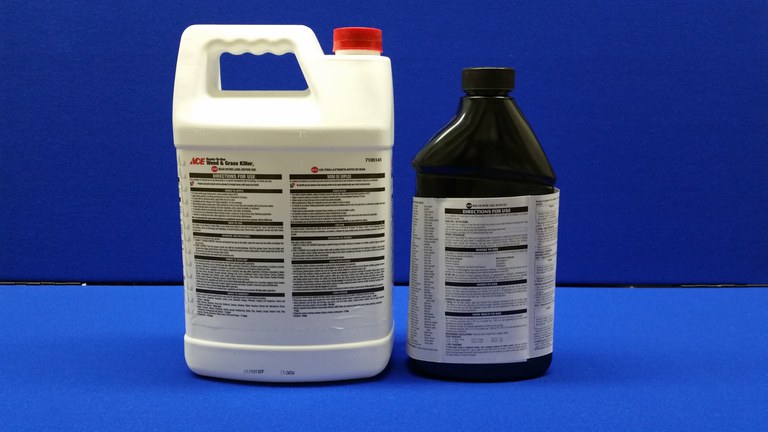
Figure 1. Consult the pesticide label for washing prohibitions or special laundering instructions. (NDSU photo)
Minimize Pesticide Residues in the Home and Avoid Human Exposure
Pesticide labels require pesticide applicators, handlers and workers to protect themselves and others from exposure to pesticides. Thus, pesticide-contaminated clothing should be handled as follows:
- While outdoors, shake, sweep or dust off the clothing with compressed air and remove any dry material from the clothing. Pay special attention to cuffs and pockets where residues often collect.
- Remove clothing outside the home or establish a changing place in the home that can be decontaminated easily after each use.
- Launder clothes as soon as possible. Studies indicate that holding clothes for 24 hours or more significantly reduces the washing efficiency.
- If you don’t wash clothes immediately:
- Store them outside the home in a garage, shop or porch if possible. Otherwise, store them in a designated area in the home that can be decontaminated easily after each use.
- Store separately from other household clothing in a plastic garbage bag or sealed, dedicated container. (Figure 2)
- Contaminated clothes should be washed separately from other household laundry.
- The person responsible for washing clothes should avoid skin exposure from the contaminated clothing by wearing a long-sleeved shirt and waterproof gloves when loading the washing machine. (Figure 3)
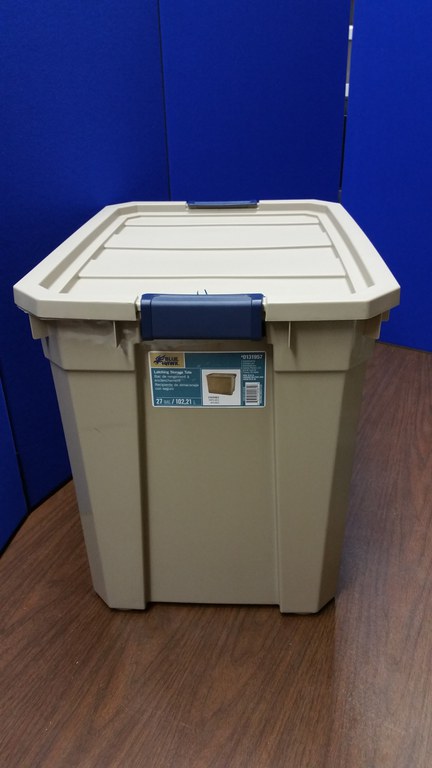
Figure 2. Plastic storage bin with sealable lid available at most home improvement stores. (NDSU photo)
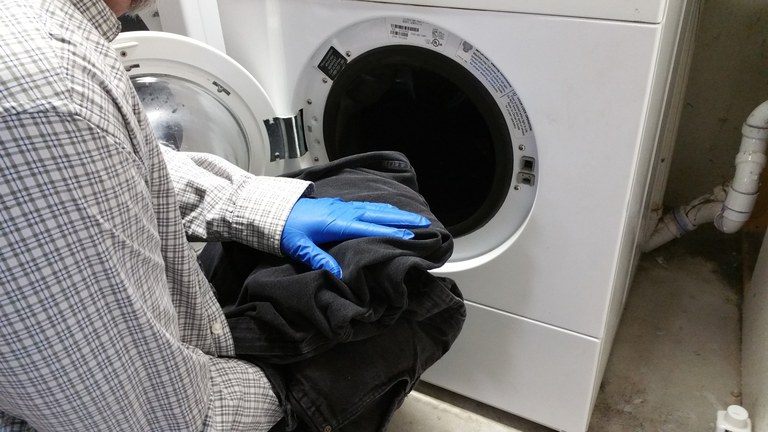
Figure 3. Wear a long-sleeved shirt and waterproof gloves to minimize skin exposure when loading the washer with pesticide-contaminated clothing. (NDSU photo)
Use Optimum Wash Settings and Decontaminate Washer After Use
- If available, read the manufacturer’s directions for operating your particular machine. The directions often provide tips and detailed descriptions on how to achieve the best results. (Figure 4)
- Load only a few items into the washing machine. The washer provides the best agitation and dilution when it is loaded to no more than 50 to 75 percent of its clothing capacity.
- Use the maximum amount of detergent the machine’s manufacturer recommends.
- Detergents and supplemental wash tips:
- Use high-quality detergents and avoid products termed “gentle detergents” that are designed for fragile fabrics or baby clothing.
- Liquid or dry detergents provide similar wash efficiency when used with sufficient water volume, duration, agitation and temperature.
- Bleach or ammonia has not been demonstrated to help remove pesticides consistently. (Figure 5)
- Pre-treating garments with stain-removal products does not improve wash efficiency significantly.
- Fabric softeners do not help remove pesticide residues.
- Pouches or pods containing detergents have not been evaluated for their ability to remove pesticides from fabrics.
- Use the highest water setting available, regardless of load size, to maximize dilution.
- Use hot water. High temperatures disperse detergents and pesticides more efficiently than warm water, and especially more than cold water.
- Use a pre-rinse/soak before initiating the wash cycle. Research shows this aids in removing pesticide residues.
- Use an aggressive wash cycle that lasts at least 20 minutes. You may need to reset the wash cycle manually to achieve this with older and/or basic machines.
- Use a high-speed spin. If this feature is not available, reset the machine manually to increase the spin time to further remove moisture and contaminants from the clothing.
- Run one additional empty cycle without clothing, using detergent and hot water, before using the washer for household laundry.
- If practical, dry clothes outside on a clothesline. Otherwise, dry clothes in a dryer or hang inside.
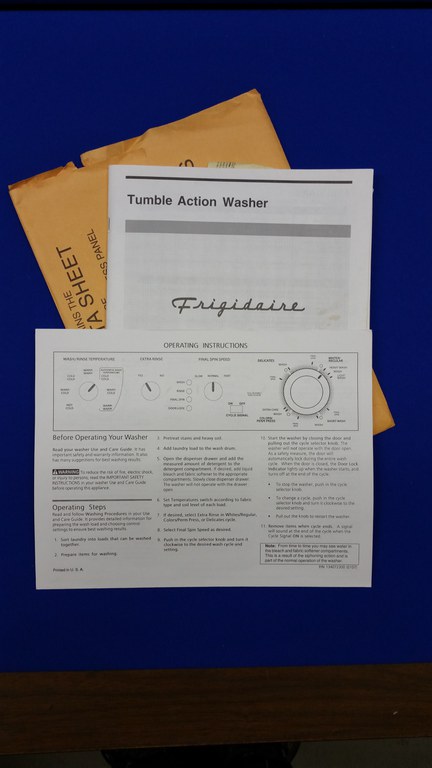
Figure 4. User manual. (NDSU photo)
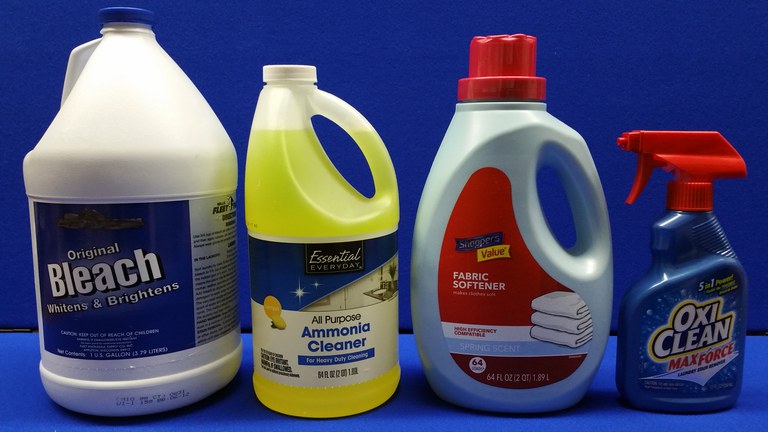
Figure 5. Bleach, ammonia, fabric softener and stain treatment products do not improve wash efficiency. (NDSU photo)
Additional Points to Consider
Research on laundering pesticide-contaminated work clothing primarily was conducted in the 1980s and early 1990s. Since then, significant changes have occurred in pesticide toxicity and formulation, detergents, washing machines and clothing design/finishing.
Pesticide toxicity
Generally, pesticides used today are of lower toxicity and less persistent in the environment, and the amount of active ingredient necessary to control pests is significantly lower. Pesticide manufacturers and equipment suppliers also have made important advancements in formulation/packaging and engineering controls to further reduce applicator exposure.
Still, pesticides are considered toxic agents, and many pose a health risk to applicators and other individuals who may come in contact with them, especially if label instructions and best management practices are not followed. The development of a good laundering routine continues to play an important role in protecting the applicator and other members of the household.
Laundry detergents
Laundry detergents are different than the ones used in the above studies. The detergents no longer contain phosphates due to environmental concerns. Significant improvements in detergent performance have occurred in recent years, particularly in their ability to tolerate hard water, disperse contaminates and break down quickly after use. In addition, consumers are moving increasingly to liquid-based detergents because they are easier to use.
Also, manufacturers are selling encapsulated, highly concentrated liquid detergents in water-dissolvable pouches or pods. (Figure 6)
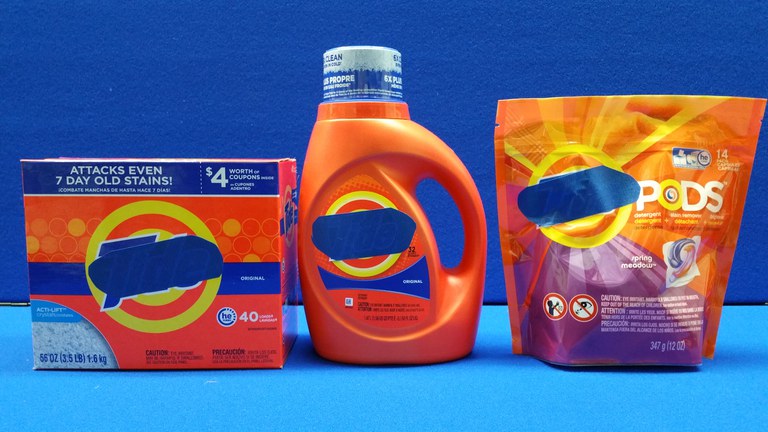
Figure 6. Dry detergent, liquid detergent and detergent-containing pods. (NDSU photo)
Pods have not been evaluated for efficacy in removing pesticides from contaminated clothing. Regardless of what detergent is employed, if it is used in conjunction with other proper laundering procedures, work clothes that are lightly or moderately contaminated can be cleaned to acceptable levels for future use.
Washing machine design
Since the 1990s, the trends have been toward:
- Digital controls,which enable a wide array of customizable wash settings (Figure 7). These features add multiple possibilities for improving pesticide removal from clothing. They include:
- A programmable pre-soak cycle
- A wash cycle that easily can be set for aggressive agitation and extended for an hour or more (Note: A more conventional wash cycle may last only 20 to 30 minutes.)
- Customizable spin setting duration and speed
- Rinse cycle duration and intensity can be varied - Thus, the rinse cycle can be extended for several minutes and/or you can use an additional rinse cycle.
- Steam-assisted cleaning, which traditionally has been used in commercial laundries
It is becoming widely available to consumers. Steam cleaning has not been evaluated for removing pesticide contaminants, however. - Superheated water being used in some washers to sanitize heavily soiled garments
A heating element in the machine takes water from the domestic hot water line and heats it to temperatures of 150 to 160 F. The feature is especially useful for cleaning heavily soiled diapers or reducing allergens in bedding. (Figure 8) This option likely would improve the removal of pesticides from garments, but it has not been evaluated. - Front- or top-load machines without agitators
These are becoming widely available, but comparisons have not been made regarding their relative efficiency in removing pesticide contaminants from clothing. - Basic, mechanically controlled machines posing challenges for cleaning pesticide-contaminated clothing (Figure 9)
Often, high-temperature washes and rinses are not available in certain models, and water-saving settings may not be adjustable. In these situations, increasing the duration of the wash cycle or using two wash cycles partially may offset these limitations, but the efficacy of these substitutions have not been evaluated. - Water and energy conservation are national priorities
In some drought-stricken parts of the country, water shortages mandate conservation, so the practices and principles outlined in this publication may conflict with these directives. Research has demonstrated that lowering water quantity and temperature likely will reduce the effectiveness of pesticide removal from clothing. In these situations:- Applicators should redouble efforts to avoid pesticide contamination during handling, loading, mixing and application of pesticides.
- To get the best wash efficiency, use loads closer to the 75 percent maximum capacity recommendation.
- Extending soak, wash and rinse cycle times with digitally controlled machines partially may offset the need for high temperatures and high water volumes, but no research has been done in this area.
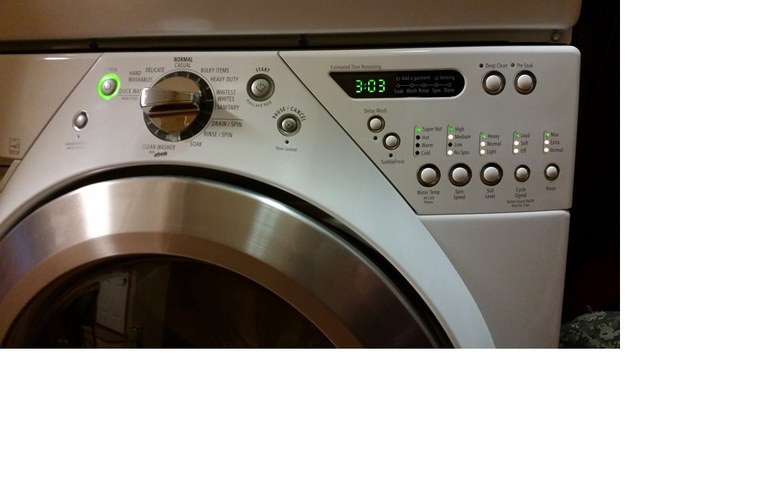
Figure 7. Front-load washing machine with digital controls. (NDSU photo)
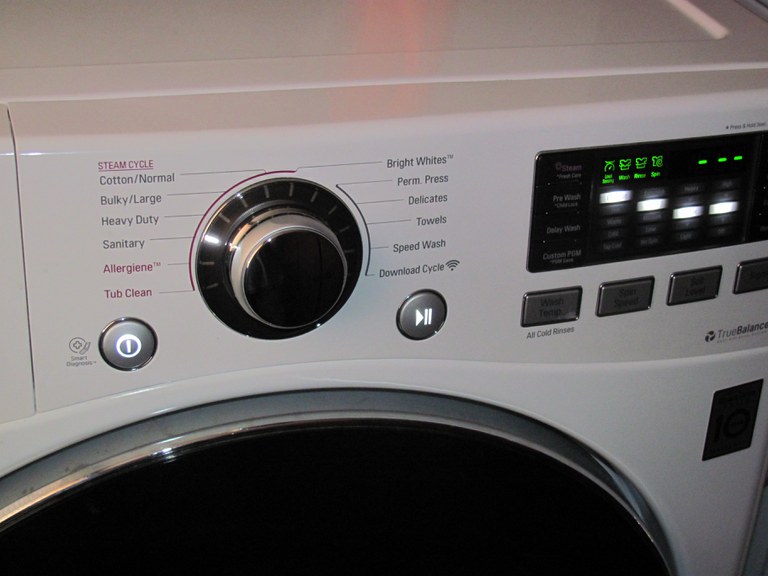
Figure 8. Digital control set to “Sanitary.” (NDSU photo)
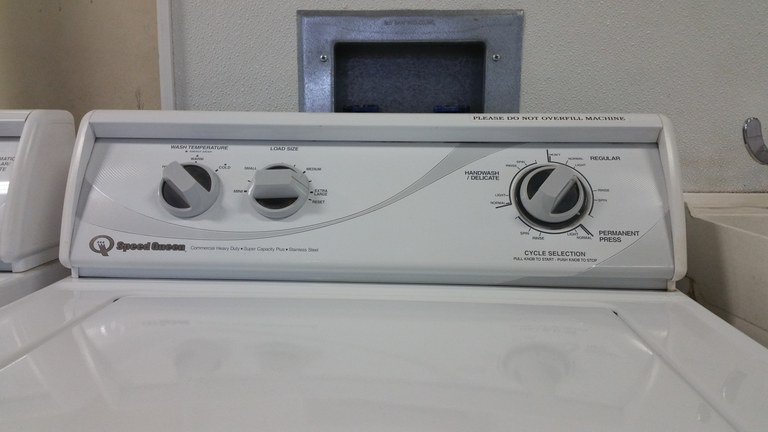
Figure 9. Basic/mechanical control panel. (NDSU photo)
Clothing Type and Design
Most of the recommendations listed in this publication have not been tested with some of the new “breathable” or synthetic fabrics. Likewise, many of the water/chemical-repellent finishes developed during the last two decades have not been evaluated. In these situations, users should check with the manufacturer of these products for cleaning recommendations.
For More Information on Pesticide Safety
Illinois
Pesticide Safety Education Program
University of Illinois Extension
1201 S. Dorner Drive
Urbana, IL 61801
Phone: (217) 244-2123
Iowa
Pesticide Safety Education Program
Iowa State University Extension and Outreach
109 Insectary
Ames, IA 50011-3140
Phone: (515) 294-1101
Michigan
Pesticide Safety Education Program
Michigan State University Extension
Food Safety & Toxicology Bldg.
1129 Farm Lane Road, Room B18
East Lansing, MI 48824-1302
Phone: (517) 353-5134
Minnesota
Pesticide Safety & Environmental Education
University of Minnesota Extension
495 Borlaug Hall
1991 Upper Buford Circle
St. Paul, MN 55108
Phone: (612) 625-9728
Nebraska
Pesticide Safety Education Program
University of Nebraska-Lincoln Extension
377C Plant Sciences Hall
Lincoln, NE 68583-0971
Phone: (402) 472-1632
North Dakota
Pesticide Training and Certification Program
North Dakota State University Extension Service
Walster Hall 205
NDSU Dept. 7060, PO Box 6050
Fargo, North Dakota 58108-6050
Phone: (701) 231-7180
Nationwide
National Pesticide Information Center
Oregon State University Extension and Outreach
310 Weniger Hall
Corvallis, OR 97331-6502
Phone: (800) 858-7378
Other State and Territory Pesticide Safety Education Programs

